2000 YAMAHA TDR 125 torque
[x] Cancel search: torquePage 46 of 104
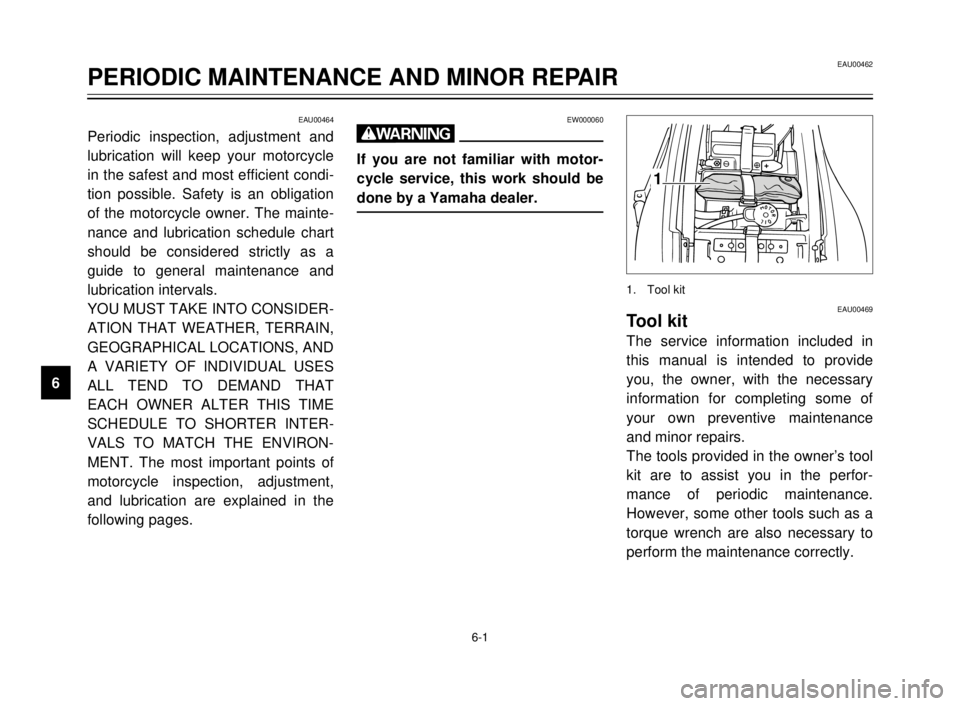
6-1
EAU00464
Periodic inspection, adjustment and
lubrication will keep your motorcycle
in the safest and most efficient condi-
tion possible. Safety is an obligation
of the motorcycle owner. The mainte-
nance and lubrication schedule chart
should be considered strictly as a
guide to general maintenance and
lubrication intervals.
YOU MUST TAKE INTO CONSIDER-
ATION THAT WEATHER, TERRAIN,
GEOGRAPHICAL LOCATIONS, AND
A VARIETY OF INDIVIDUAL USES
ALL TEND TO DEMAND THAT
EACH OWNER ALTER THIS TIME
SCHEDULE TO SHORTER INTER-
VALS TO MATCH THE ENVIRON-
MENT. The most important points of
motorcycle inspection, adjustment,
and lubrication are explained in the
following pages.
EW000060
w
If you are not familiar with motor-
cycle service, this work should be
done by a Yamaha dealer.
EAU00462
PERIODIC MAINTENANCE AND MINOR REPAIR
1
2
3
4
5
6
7
8
9
1
EAU00469Tool kit
The service information included in
this manual is intended to provide
you, the owner, with the necessary
information for completing some of
your own preventive maintenance
and minor repairs.
The tools provided in the owner’s tool
kit are to assist you in the perfor-
mance of periodic maintenance.
However, some other tools such as a
torque wrench are also necessary to
perform the maintenance correctly.
1. Tool kit
5AE-9-E3 (ENG) 4/11/0 11:06 AM Page 44
Page 53 of 104
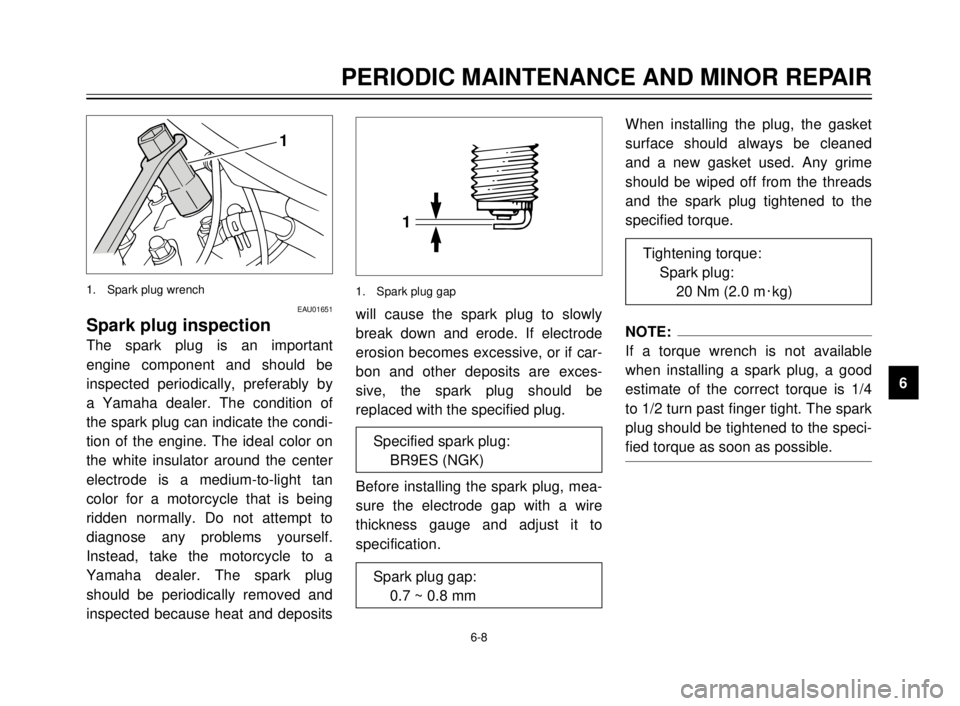
6-8
1
EAU01651
Spark plug inspection
The spark plug is an important
engine component and should be
inspected periodically, preferably by
a Yamaha dealer. The condition of
the spark plug can indicate the condi-
tion of the engine. The ideal color on
the white insulator around the center
electrode is a medium-to-light tan
color for a motorcycle that is being
ridden normally. Do not attempt to
diagnose any problems yourself.
Instead, take the motorcycle to a
Yamaha dealer. The spark plug
should be periodically removed and
inspected because heat and depositswill cause the spark plug to slowly
break down and erode. If electrode
erosion becomes excessive, or if car-
bon and other deposits are exces-
sive, the spark plug should be
replaced with the specified plug.
Before installing the spark plug, mea-
sure the electrode gap with a wire
thickness gauge and adjust it to
specification.When installing the plug, the gasket
surface should always be cleaned
and a new gasket used. Any grime
should be wiped off from the threads
and the spark plug tightened to the
specified torque.NOTE:
If a torque wrench is not available
when installing a spark plug, a good
estimate of the correct torque is 1/4
to 1/2 turn past finger tight. The spark
plug should be tightened to the speci-
fied torque as soon as possible.
1. Spark plug wrench
PERIODIC MAINTENANCE AND MINOR REPAIR
1
2
3
4
5
6
7
8
9 Specified spark plug:
BR9ES (NGK)
Spark plug gap:
0.7 ~ 0.8 mm
Tightening torque:
Spark plug:
20 Nm (2.0 m0kg)
1
1. Spark plug gap
5AE-9-E3 (ENG) 4/11/0 11:06 AM Page 51
Page 55 of 104
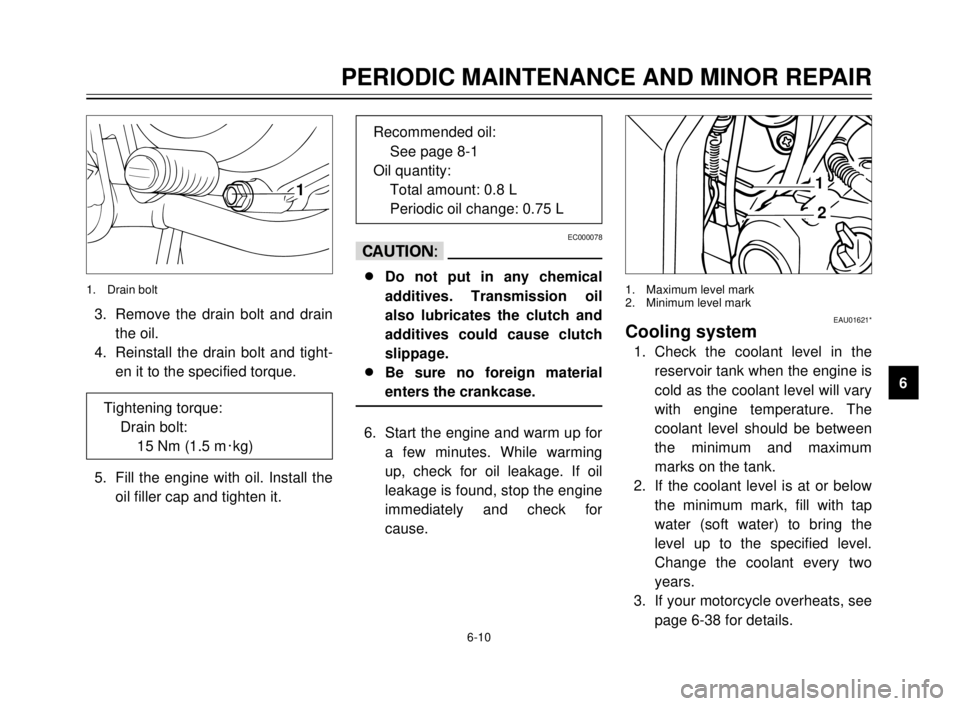
6-10
1
3. Remove the drain bolt and drain
the oil.
4. Reinstall the drain bolt and tight-
en it to the specified torque.
5. Fill the engine with oil. Install the
oil filler cap and tighten it.
EC000078
cC
8
8
Do not put in any chemical
additives. Transmission oil
also lubricates the clutch and
additives could cause clutch
slippage.
8 8
Be sure no foreign material
enters the crankcase.
6. Start the engine and warm up for
a few minutes. While warming
up, check for oil leakage. If oil
leakage is found, stop the engine
immediately and check for
cause.
1. Drain bolt
PERIODIC MAINTENANCE AND MINOR REPAIR
1
2
3
4
5
6
7
8
9 Tightening torque:
Drain bolt:
15 Nm (1.5 m0kg)
Recommended oil:
See page 8-1
Oil quantity:
Total amount: 0.8 L
Periodic oil change: 0.75 L
1
2
1. Maximum level mark
2. Minimum level mark
EAU01621*Cooling system
1. Check the coolant level in the
reservoir tank when the engine is
cold as the coolant level will vary
with engine temperature. The
coolant level should be between
the minimum and maximum
marks on the tank.
2. If the coolant level is at or below
the minimum mark, fill with tap
water (soft water) to bring the
level up to the specified level.
Change the coolant every two
years.
3. If your motorcycle overheats, see
page 6-38 for details.
5AE-9-E3 (ENG) 4/11/0 11:06 AM Page 53
Page 57 of 104
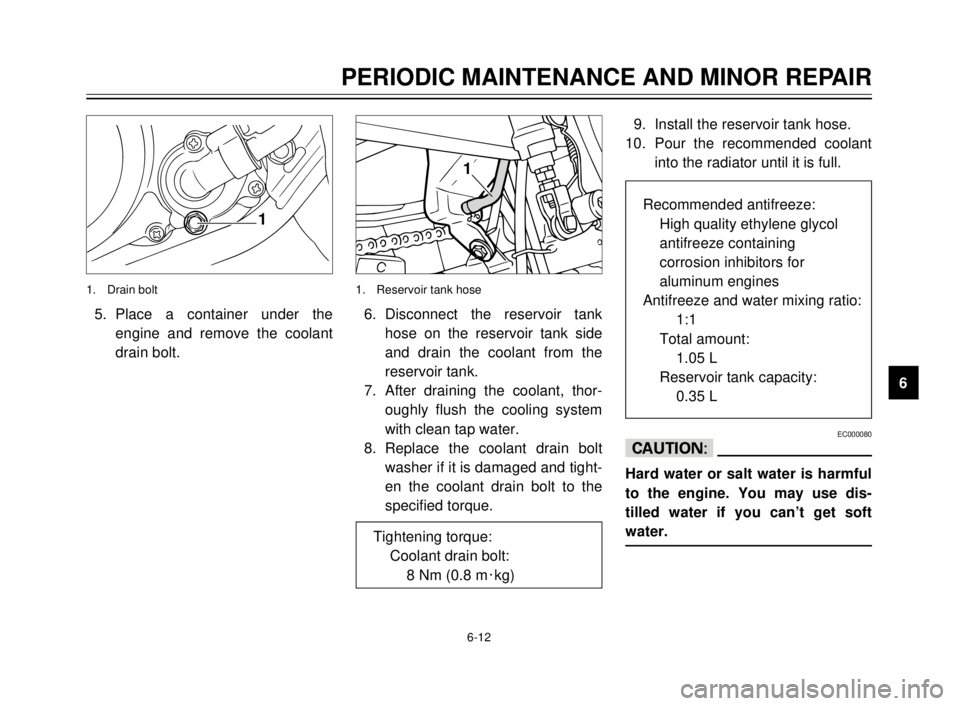
6-12
PERIODIC MAINTENANCE AND MINOR REPAIR
1
2
3
4
5
6
7
8
9
1
5. Place a container under the
engine and remove the coolant
drain bolt.
1. Drain bolt
1
6. Disconnect the reservoir tank
hose on the reservoir tank side
and drain the coolant from the
reservoir tank.
7. After draining the coolant, thor-
oughly flush the cooling system
with clean tap water.
8. Replace the coolant drain bolt
washer if it is damaged and tight-
en the coolant drain bolt to the
specified torque.
1. Reservoir tank hose
Tightening torque:
Coolant drain bolt:
8 Nm (0.8 m0kg)
9. Install the reservoir tank hose.
10. Pour the recommended coolant
into the radiator until it is full.
EC000080
cC
Hard water or salt water is harmful
to the engine. You may use dis-
tilled water if you can’t get soft
water.
Recommended antifreeze:
High quality ethylene glycol
antifreeze containing
corrosion inhibitors for
aluminum engines
Antifreeze and water mixing ratio:
1:1
Total amount:
1.05 L
Reservoir tank capacity:
0.35 L
5AE-9-E3 (ENG) 4/11/0 11:06 AM Page 55
Page 69 of 104
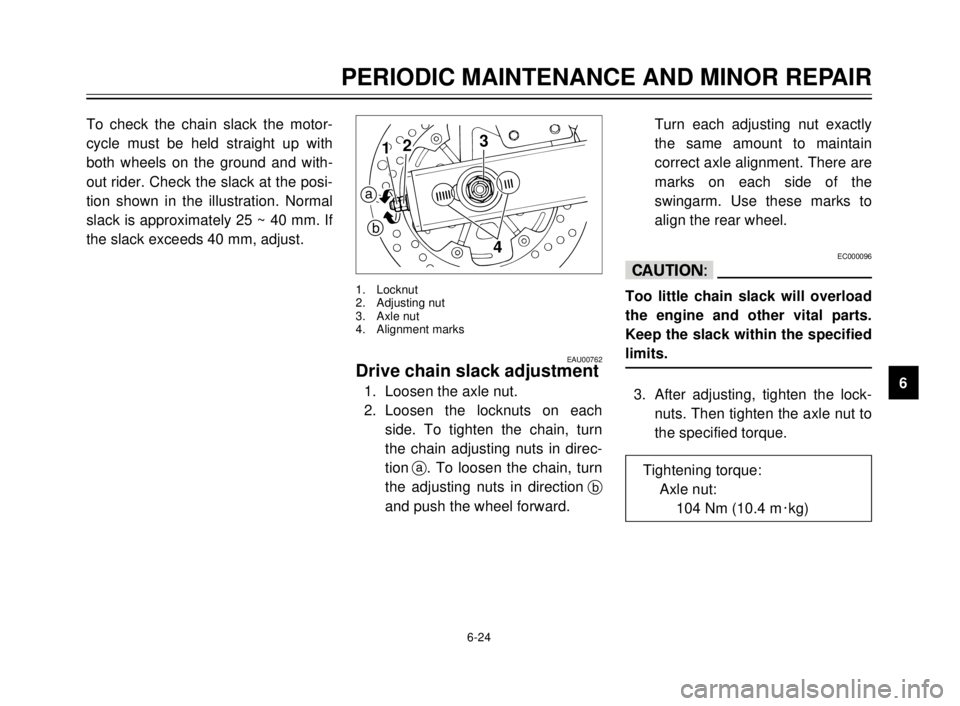
6-24
PERIODIC MAINTENANCE AND MINOR REPAIR
1
2
3
4
5
6
7
8
9 To check the chain slack the motor-
cycle must be held straight up with
both wheels on the ground and with-
out rider. Check the slack at the posi-
tion shown in the illustration. Normal
slack is approximately 25 ~ 40 mm. If
the slack exceeds 40 mm, adjust.
EAU00762Drive chain slack adjustment
1. Loosen the axle nut.
2. Loosen the locknuts on each
side. To tighten the chain, turn
the chain adjusting nuts in direc-
tiona. To loosen the chain, turn
the adjusting nuts in directionb
and push the wheel forward.
3
412
a
b
1. Locknut
2. Adjusting nut
3. Axle nut
4. Alignment marks
Turn each adjusting nut exactly
the same amount to maintain
correct axle alignment. There are
marks on each side of the
swingarm. Use these marks to
align the rear wheel.
EC000096
cC
Too little chain slack will overload
the engine and other vital parts.
Keep the slack within the specified
limits.
3. After adjusting, tighten the lock-
nuts. Then tighten the axle nut to
the specified torque.
Tightening torque:
Axle nut:
104 Nm (10.4 m0kg)
5AE-9-E3 (ENG) 4/11/0 11:06 AM Page 67
Page 79 of 104
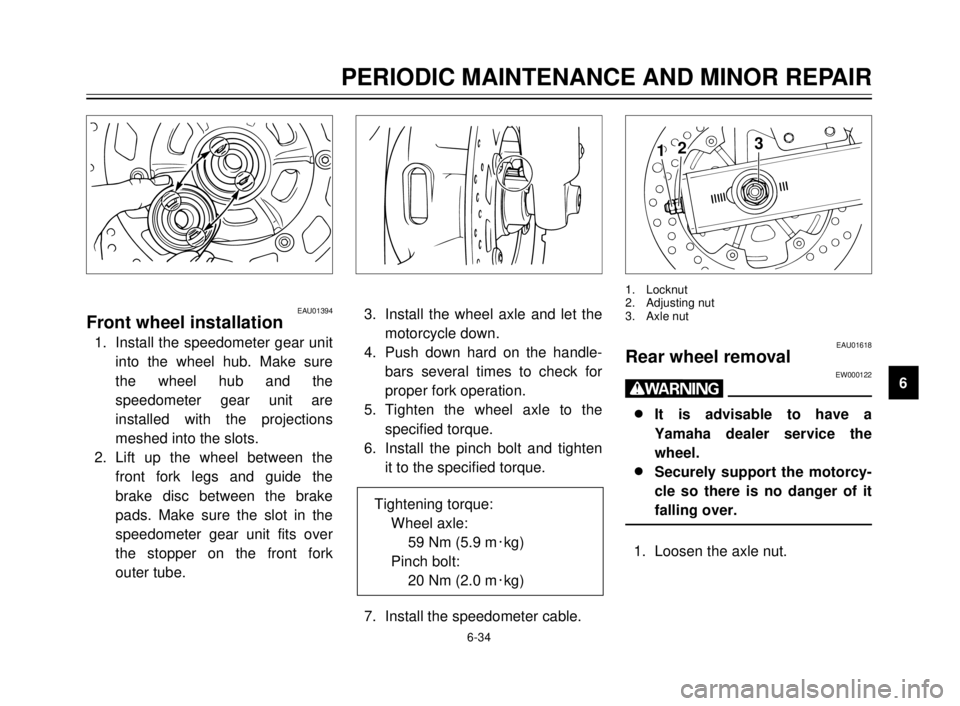
6-34
PERIODIC MAINTENANCE AND MINOR REPAIR
1
2
3
4
5
6
7
8
9
3. Install the wheel axle and let the
motorcycle down.
4. Push down hard on the handle-
bars several times to check for
proper fork operation.
5. Tighten the wheel axle to the
specified torque.
6. Install the pinch bolt and tighten
it to the specified torque.
7. Install the speedometer cable.Tightening torque:
Wheel axle:
59 Nm (5.9 m0kg)
Pinch bolt:
20 Nm (2.0 m0kg)
312
EAU01618Rear wheel removalEW000122
w
8 8
It is advisable to have a
Yamaha dealer service the
wheel.
8 8
Securely support the motorcy-
cle so there is no danger of it
falling over.
1. Loosen the axle nut.
1. Locknut
2. Adjusting nut
3. Axle nut
EAU01394Front wheel installation
1. Install the speedometer gear unit
into the wheel hub. Make sure
the wheel hub and the
speedometer gear unit are
installed with the projections
meshed into the slots.
2. Lift up the wheel between the
front fork legs and guide the
brake disc between the brake
pads. Make sure the slot in the
speedometer gear unit fits over
the stopper on the front fork
outer tube.
5AE-9-E3 (ENG) 4/11/0 11:06 AM Page 77
Page 81 of 104
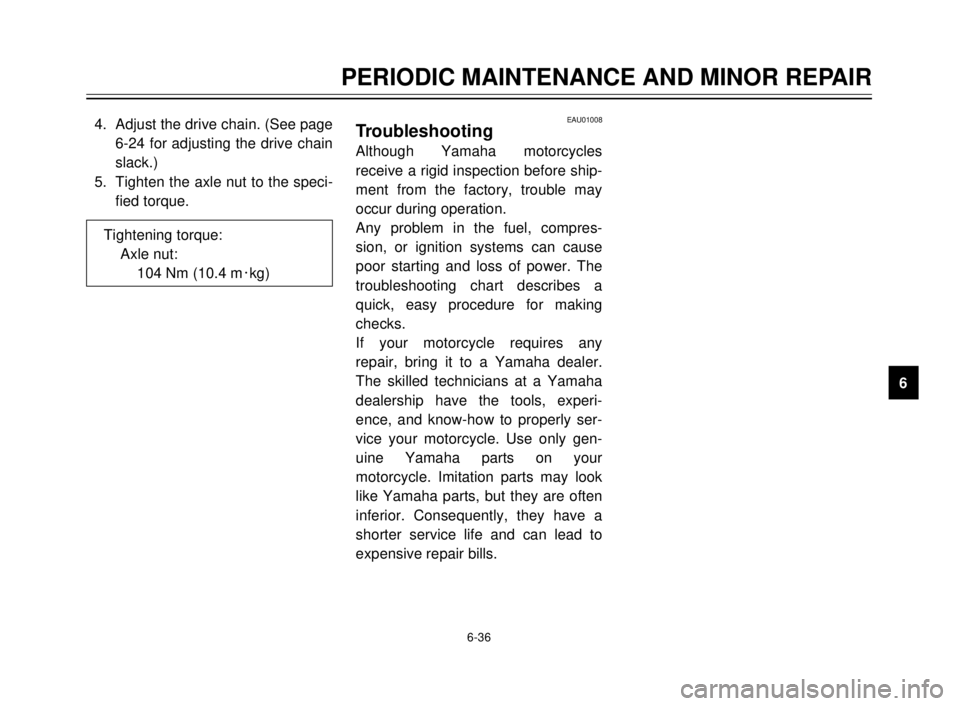
6-36
PERIODIC MAINTENANCE AND MINOR REPAIR
1
2
3
4
5
6
7
8
9 4. Adjust the drive chain. (See page
6-24 for adjusting the drive chain
slack.)
5. Tighten the axle nut to the speci-
fied torque.
Tightening torque:
Axle nut:
104 Nm (10.4 m0kg)
EAU01008Troubleshooting
Although Yamaha motorcycles
receive a rigid inspection before ship-
ment from the factory, trouble may
occur during operation.
Any problem in the fuel, compres-
sion, or ignition systems can cause
poor starting and loss of power. The
troubleshooting chart describes a
quick, easy procedure for making
checks.
If your motorcycle requires any
repair, bring it to a Yamaha dealer.
The skilled technicians at a Yamaha
dealership have the tools, experi-
ence, and know-how to properly ser-
vice your motorcycle. Use only gen-
uine Yamaha parts on your
motorcycle. Imitation parts may look
like Yamaha parts, but they are often
inferior. Consequently, they have a
shorter service life and can lead to
expensive repair bills.
5AE-9-E3 (ENG) 4/11/0 11:06 AM Page 79
Page 96 of 104
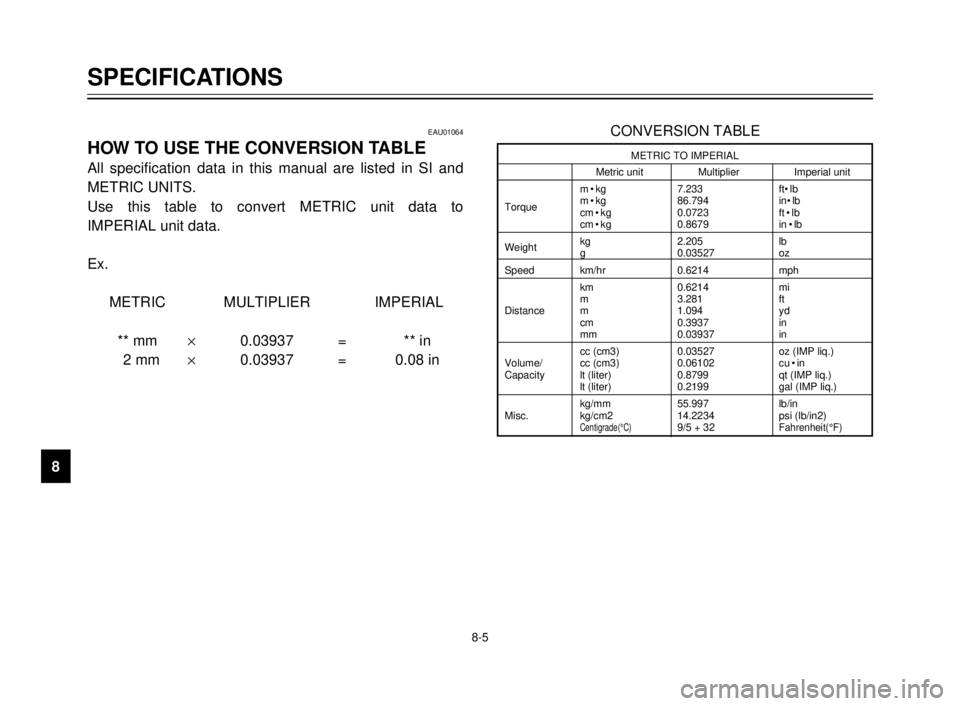
SPECIFICATIONS
1
2
3
4
5
6
7
8
9
8-5
EAU01064
HOW TO USE THE CONVERSION TABLE
All specification data in this manual are listed in SI and
METRIC UNITS.
Use this table to convert METRIC unit data to
IMPERIAL unit data.
Ex.
METRIC MULTIPLIER IMPERIAL
** mm´0.03937 = ** in
2 mm´0.03937 = 0.08 inMETRIC TO IMPERIAL
Metric unit Multiplier Imperial unit
m • kg 7.233 ft• lb
Torquem • kg 86.794 in• lb
cm • kg 0.0723 ft • lb
cm • kg 0.8679 in • lb
Weightkg 2.205 lb
g 0.03527 oz
Speed km/hr 0.6214 mph
km 0.6214 mi
m 3.281 ft
Distance m 1.094 yd
cm 0.3937 in
mm 0.03937 in
cc (cm3) 0.03527 oz (IMP liq.)
Volume/ cc (cm3) 0.06102 cu • in
Capacity lt (liter) 0.8799 qt (IMP liq.)
lt (liter) 0.2199 gal (IMP liq.)
kg/mm 55.997 lb/in
Misc. kg/cm2 14.2234 psi (lb/in2)
Centigrade(°C)9/5 + 32Fahrenheit(°F)
CONVERSION TABLE
5AE-9-E3 (ENG) 4/11/0 11:06 AM Page 94